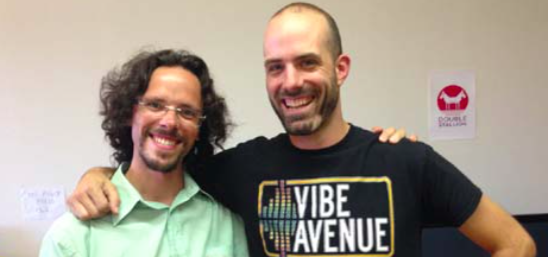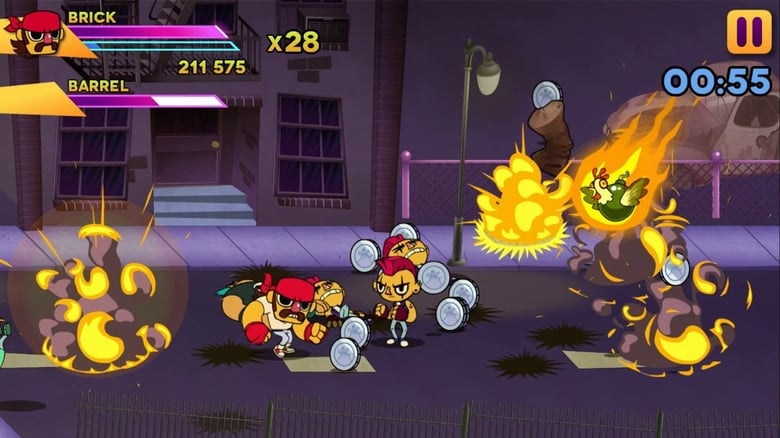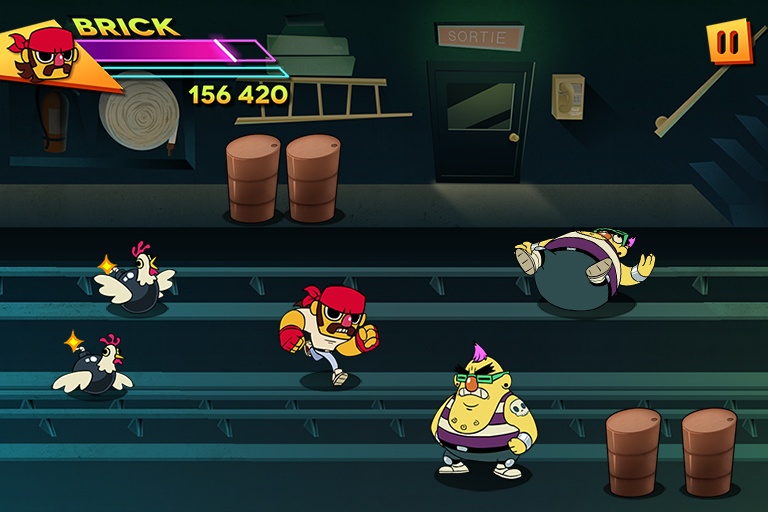In July 2014, Big Action Mega Fight! won the “Best Game Audio” award at Casual Connect USA in San Francisco, as part of the Indie Prize Showcase. We are really happy for them and wanted the take a moment of their time to know a bit more how they have developed the game using Wwise. Of course, while we’re used to working with teams from all around the world, there’s a bit of extra pride as Double Stallion (the game developer) and Vibe Avenue (the audio provider) are both from Montreal - Audiokinetic’s hometown! Hope you’ll enjoy this interview with Dan Menard from Double Stallion and Mathieu Lavoie and FX Dupas from Vibe Avenue.

Background
Can you give us a bit of your background before you started working on this game?
Double Stallion (DS): Double Stallion Games was one of the first teams to go through the Execution Labs incubator, during which we worked on Big Action Mega Fight! Before then, we all did different things. Eric, our art director, held another job at a studio in Montreal and has a background in traditional animation. Vincent and I, both programmers, were working under a different brand making an independent game called Party of Sin. I personally come from the Half-Life 2 mod scene and went on to make independent games professionally. Stephane, our final co-founder, had started his own mobile games business and joined us to work on bigger and more exciting games.
Vibe Avenue (VA): We founded Vibe Avenue in January 2013 after realising that working as a team was much more productive and stimulating than working individually. Before that, we both had several years of experience as composers, sound designers and integrators for video games and visual media in general, as well as both having done graduate studies. Big Action Mega Fight! (BAMF) is one of the first games we did together at Vibe Avenue. To this date, it has been downloaded more than 500.000 times and we were lucky enough to win the Best Audio Award at Casual Connect 2014 for it, which makes us very proud. We also both teach game audio at the two main French universities in Montreal: UQAM (Université du Québec à Montréal) and University of Montreal.
Production
Why did you decide to use Wwise?
DS: The sound engine bundled with Marmalade, the game engine we used for BAMF, was rather limited. We knew we needed something more powerful and the first people we asked were our audio designers. They told us that Wwise was what we should be using, hands down. We went with their recommendation and haven’t had any reason to look for anything else. Wwise is by far the best audio engine we’ve worked with so far.
VA: At Vibe Avenue we believe that a good integration is 50% of a successful game audio experience. Thus, we try to use Wwise as often as possible as for us it’s our favorite integration tool.
Can you summarize BAMF’s gameplay and any particular challenges for audio?
DS: Big Action Mega Fight is an action-packed brawler for mobile and micro-consoles. We built the game as a throwback to old-school classics like Streets of Rage and Final Fight, but with modern polish. The game takes a lot of inspiration from those older games, especially for audio. We wanted to immerse players in late 80s action, and a key component of that was getting the sound and music to feel right. Vibe Avenue, helped us come up with a unique audio signature for the game that fits beautifully. The music is arranged dynamically by the Wwise music engine, making it different every time it plays and reducing repetition. We also did our own voice work, and everyone on the team recorded lines that are in the game. Those were especially fun to create!
VA: To reflect the old-school aesthetic, we used a lot of FM synthesis (even emulated the Yamaha YM2612, the famous chip of the Sega Genesis) and retro synths to create “classic-sounding” melodies and sound effects, then we mixed them with modern production elements. For example, we did several foley sessions (all the impacts, destructibles and motorcycle sounds were recorded by our means) and the music includes live guitars and flutes.
Can you talk about performance and stability of Wwise for iOS?
DS: Wwise has never been the cause of a crash in our game. The engine is incredibly powerful and relatively light-weight. Wwise did take up a lot of CPU in our case due to the dynamic music of BAMF and the heavy compression we were using. This is the cost of fitting all the audio we had in BAMF in less than 20 MB.
VA: The Wwise Profiler made it easy to stay within our memory budget and avoid CPU spikes. We were even able to adapt the use of real-time DSP to the number of cores on the target platform. For example, we would use more or less reverb depending on if the game was running on the current generation of iOS devices or the previous one. We lost a little in audio quality but the game was running faster by using less CPU.
Sound Design
Can you talk of your experience with the support from Audiokinetic?
DS: The support team at Audiokinetic are rockstars. At one point during production we had an audio bug on Android which had been fixed on a later version of Wwise. We were 3 days from launch, and upgrading to the latest Wwise was just impossible in that time frame. The support people at Audiokinetic back-ported the fix for us within an hour or two, and the launch went without a hitch. You can’t get better support than that!
We worked with Audiokinetic to build the Wwise plugin for Marmalade and their tech team has always been very helpful.
Now that game developers need high quality production values to stand out in the handheld market, can you comment on Wwise as a catalyst in achieving this?
DS: Wwise saved us a ton of production time and allowed us to offload the responsibility of audio integration to our awesome audio partners at Vibe Avenue. It creates a workflow that is incredibly powerful. All we had to do was hook up events in our code, and the rest was taken care of. Our audio designers were able to be extremely creative, without having to communicate heavily with the programming team, and that’s why BAMF sounds as good as it does.
VA: Once everything is set up in Wwise, which goes usually quite fast, the event system allows the creation of very complex audio behaviours without asking the programmers anything ever again. It’s a huge plus as, in mobile development, the teams are smaller and people tend to get very busy. Wwise really helped us to achieve our creative vision on our own, without ever getting in the game developer’s way.
What audio challenges did the iOS platform bring to your sound design vision?
DS: iOS has very tight file size limits for delivering apps on mobile data. This forced us to keep our app under 50 MB. We had given ourselves a budget of 20 MB for the audio, and we squeezed as many sounds and music tracks as we could in that budget. Thanks to Wwise, it turned out to be quite a lot!
VA: Memory management was the major challenge. With careful sound editing and a little work on compression Sharesets, it was ok for the sound design part. The music part was more complex. The game features about 40 levels, and we were limited to 3 gameplay tunes (excluding the menus and cutscenes music), so we used Wwise’s great interactive music system to its fullest. Instead of rendering whole tunes, we rendered lots of small musical elements: melodies, rhythms, chords, transitions... The result took a little more memory per song, but allowed us to create infinite variations. Later, we read in one of the game’s reviews: “I don’t know exactly how much music is in the game, but I never found it repetitive”. That’s exactly what we had hoped for.
There’s a lot going on the screen at any moment in BAMF, and yet, it never seems too crowded on the audio side. Can you tell us what you’ve done for the game’s mix?
VA: Wwise made it pretty easy for us. The recipe was a combination of different tools and techniques, such as using playback limits, side-chaining, ducking, low pass filters, randomization and having a wide variety of sounds. We used playback limits everywhere. This not only makes audio less crowded, it also makes the CPU happier. We also used side-chaining on bus volume, which is even more accurate than ducking. Thanks to Simon Ashby at Audiokinetic for showing us this little trick! This made sure that music was always heard, while never being in the way of the rest of the game’s audio. Low pass filtering was applied dynamically on SFX busses for special attacks and when the game was paused.
Dialogue was one of the major challenges. In BAMF, if we had to hear enemies scream loud “ouch”, “argh” or “ow” every time they’re hit, it would have quickly sound chaotic. Because of this, we also recorded a lot of closed mouth onomatopoeias like “hmmmmfs”, which are softer and are integrated with a higher probability of being played in Wwise than louder open mouth sounds. This way, the players almost always have voice feedback when they punch someone, but the voice feedback doesn’t get annoying.
Any favourite Wwise features you’d like to mention?
DS: My favorite feature is the easy integration into the game! We really don’t even need to touch the Wwise Authoring system anymore – we leave that to the sound designers!
VA: Yes, a lot! We already mentioned the event system and the interactive music capabilities. The Soundcaster is great. The profiler is fantastic. The ability to edit sounds directly in Wwise is very handy. We’re also looking forward to using the great features introduced in the new version, like the MIDI support and Wwise Synth One.
Anything you’d like to add?
DS: Our next game is called Luna and its audio will also be powered by Wwise.
VA: Thank you for making the tool that allows us to create great game audio!

DOUBLE STALLION
From left to right:
- Eric Angelillo, Art Director & Animator
- Nicolas Barriere, Game Designer & PR and Community
- Stephane Beniak, Game Designer & Programmer
- Vincent Hippoman, Programmer & Programmer
- Daniel Menard, CEO & Programmer

FX Dupas and Mathieu Lavoie - Co-founders, composers and audio artists




Commentaires